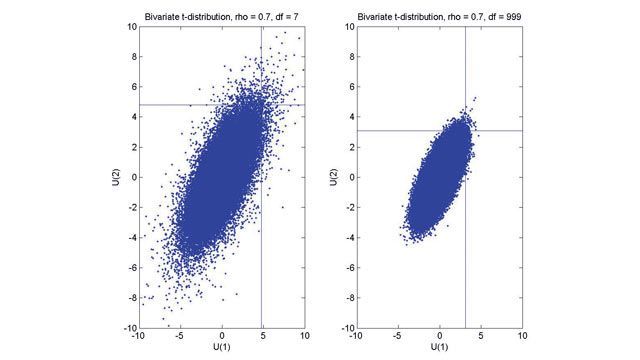Capgemini Helps Clients Achieve Basel II Compliance and Deliver Economic Capital, Risk, and Valuation Models
“Some statistical tools can handle credit scoring models based on multivariate statistics or logistic regression, but are not well-suited to the advanced economic capital models needed for Basel II. With its computational power, matrix infrastructure, and ability to perform Monte Carlo simulations, MATLAB gives us a competitive advantage in performing complex risk analyses.”
Challenge
Solution
Results
- Strong competitive advantage established
- Scalable solution delivered
- Customer portfolio revalued

To ensure risk compliance and to improve management’s understanding of their complex balance sheets, financial service firms are working to reevaluate risk analysis methods and risk management processes. One notable area of focus is regulatory and economic capital; the Basel II Accord, for instance, provides guidance for banks to set aside capital and establish strategies based on accurate calculation of market, credit, and operational risks. However, firms must also ensure that they assess and communicate interest-rate, business, strategic, and other risks throughout the enterprise.
Consultants at Capgemini, an international provider of consulting, technology, and outsourcing services, use MathWorks tools for the calculation of regulatory and economic capital, as well as for valuation and other facets of risk management.
“We use MATLAB to implement very complex models for economic capital and valuation that enable banks to analyze risk systematically,” says Dr. Marco Folpmers, principal consultant at Capgemini. “We also deliver the MATLAB code to our clients so that their technical staff can work with it and build on it. This service sets us apart from our competitors.”
Challenge
Capgemini’s clients, which include every leading Dutch bank as well as many other banks throughout Europe, can hold loan portfolios worth several hundred billion euros and comprising thousands of individual loans. To accurately assess credit risk and ensure adequate regulatory and economic capital, Capgemini must take into account the probability of default, loss given default, and exposure at default for each loan, as well as the concentration of the loans in various sectors and regions.
“The problems we are working on do not have analytical solutions,” says Dr. Folpmers. “Instead, we must conduct Monte Carlo simulations for a wide range of market conditions, portfolios, and time frames.”
The banks need to understand the analysis results to make informed business decisions. Because risk management directors do not necessarily have technical backgrounds, Capgemini needed to visualize results for their clients. “For instance, if a portfolio is heavily weighted in energy, we can show them how the level of concentration increases their capital requirement,” Folpmers explains.
Solution
Capgemini consultants used MATLAB® and companion toolboxes to implement valuation models and risk models that enable their client banks to simulate risk scenarios and comply with Basel II standards. Many of the consultants have backgrounds in fields such as econometrics or physics, and typically learned MATLAB in college.
Capgemini accessed client financial data from Teradata products and other data warehouses using Database Toolbox™. To ensure that the data was clean and complete, the team used MATLAB to identify outliers, compute missing values, and exclude invalid values.
The consultants reused components they had developed in MATLAB to implement economic capital models for different banks. For some components, such as copula modeling, they incorporated techniques and code examples downloaded from MATLAB Central.
To calculate economic capital, Capgemini performed Monte Carlo simulations in MATLAB to estimate an empirical distribution of losses. The team used histograms and other graphical tools in MATLAB to help clients visualize risks and capital requirements, and to demonstrate that the simulations had converged, yielding stable results. MATLAB is also used to implement integrated approaches that combine credit, interest-rate, operational, and other risks across client organizations.
For these and other risk projects, the team used Financial Toolbox™ to apply Markowitz and Black-Scholes models to their analysis. With Statistics and Machine Learning Toolbox™, they incorporated cluster analysis, principal component analysis, copula analysis, multivariate hypothesis testing, and statistical validation.
For clients who do not have MATLAB installed, Capgemini used MATLAB Compiler™ to create standalone executables. In one instance, Capgemini generated an executable file that its customer incorporated into a graphical risk management dashboard.
Results
Strong competitive advantage established. “We have set ourselves apart from our competitors by delivering MATLAB code to our customers, who can use it and build upon it as they wish,” says Folpmers. “MathWorks tools have helped Capgemini deliver customer solutions for Basel II and become the number one consultancy in the Dutch banking industry for quantitative economic capital modeling.”
Scalable solution delivered. “We work with some of the biggest banks in Europe, but we have never encountered a situation that was too complex or a portfolio that was too large to analyze with MATLAB,” Folpmers notes. “MATLAB is flexible, provides a rich set of built-in functions, and enables quick simulation of large, complex models.”
Customer portfolio revalued. “One of our customers had a portfolio of residential mortgage-backed securities, with a mark-to-market value far below their actual value based on prices quoted in the Bloomberg system,” says Folpmers. “With MATLAB, we demonstrated to the bank and its accounting firm a buy-and-hold mark-to-model valuation that reduced the impairment by tens of millions of euros, which represented a significant fraction of the bank’s profits.”